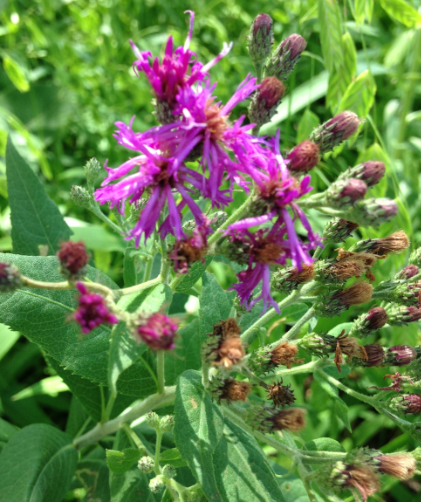The problem with weeds is that they grow so well. If only the plants I love would flourish like the weeds in my yard do. Weeds can take the fun out of gardening, and during years with so much moisture, like 2016, they spread like a wildfire.
Here are some weeds we are waging war against in our perennial gardens. The difficulty is that every weed seems to require a different control measure. The common themes are that these weeds demand immediate eradication or ruthless elimination. As soon as you see them, spray, pull, hoe, or dig them out. These weeds can be relentless and you need to remove them from your garden as if you were trying to remove the plague.
Bindweed
I was at the state fair this weekend and stopped by the noxious weed booth. (Don’t judge me because I am a plant geek.) The thing that struck me was the display of how much one bindweed seed can grow in one year. It’s amazing that it was able to produce so many new plants and that the roots could grow 30 feet deep. No wonder it is so hard to get rid of in a garden.
Obviously, the best time to eradicate bindweed is before you plant. I spray the area with Roundup™ several times starting in July and August. Anytime we see green, the area is sprayed. This is the best time to spray because the plant is moving energy from the leaves into the roots for winter storage. The chemical is also moved throughout the extensive root system, killing even those deep roots. On the other hand, spring is not a good time to spray bindweed, because the plant is moving everything from the roots upward to produce new growth. If you spray at that time, you will not kill the roots. Make sure it is completely gone before planting. Trust me, it is worth waiting to plant until this weed is removed permanently.
We have had limited success controlling bindweed by solarizing an area with clear plastic. This process starts by laying a clear tarp on the soil surface and anchoring the edges with soil or bricks and leaving it in place for several months. The problem with this method is that it kills the surface roots, but does nothing to the deep roots that will sprout after the plastic is removed. The plant may be weakened but not completely eliminated.
Small patches can be hand pulled but you have to stay on it. Every sprig that pops up must be pulled immediately. We have also had limited success with hand painting the leaves with Round-up. Again, every new plant must be found and painted. Essentially, you have to be as ruthless and relentless as this weed is to completely remove it from your garden. I thank my ancestors for bringing this over to America with their wheat seed.
Bermuda grass
This perennial grass is a problem because of its vigorous creeping habit. The plant spreads by seeds and by above and below ground stems that can take over a garden in one season. It is drought tolerant and thrives with neglect.
Like bindweed, bermudagrass is best removed before planting (same as bindweed). If you have it growing next to your gardens, a buffer must be maintained between the perennial display and the lawn area. This buffer can be sprayed every few weeks with Roundup™ to burn back any new runners toward the garden. Raised beds are another defense against bermuda grass. Don’t blow bermuda grass clippings into your gardens.
People have had success with solarizing their area before planting, because the roots are not as deep as bindweed. Another method requires mowing the area closely. Next, put down a layer of thick cardboard making sure to leave no gaps. Next, spread a layer of leaves at least 6 inches deep. As time goes on make sure no plants emerge through the leaves. The area can be planted in 6-8 weeks by cutting small holes through the cardboard.
Nutsedge
This weed loves our mulched beds. The yellow nutsedge and purple nutsedge spread quickly in areas with little or no competition, garden areas that are regularly watered and poorly drained, rich soil.
This problem weed has triangular grass-like leaves and forms a colony if left unchecked. Nutsedges produce underground tubers, and runners that make it difficult to pull out of the ground. Each of these can produce another plant if not completely removed. Again, you need to relentlessly pull the plants every time a new plant emerges. It is most active in May through October.
We have had more success spraying nutsedge. We use Manage™ (Sledgehammer) herbicide. It is a selective herbicide that only kills nut sedge. It can be sprayed in close proximity to other perennials, shrubs and trees. It takes a few weeks for the plants to show decline, but Manage™ kills the whole plant including the runners and tubers.
“Weeds” are plants out of place. Some of us have more plants out of place than others, but we all can have success in controlling them. It takes time. It takes persistence. It takes endurance to ultimately get these weeds controlled. If you have them, I am sorry. If they are out of control, you will need to evaluate whether it is easier to start over or systematically begin to remove these weeds. It can be done. Hang in there, but be as unrelenting as the weeds. I wish I had better news. As they say on the Red Green Show, “We are all in this together. I am pulling for you.”






